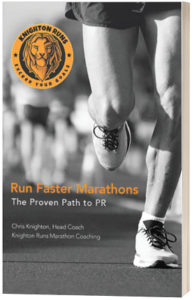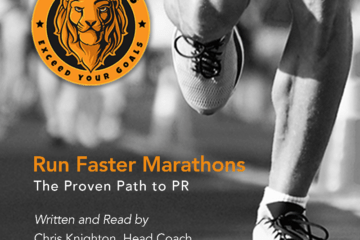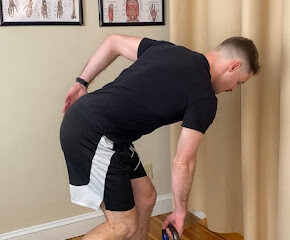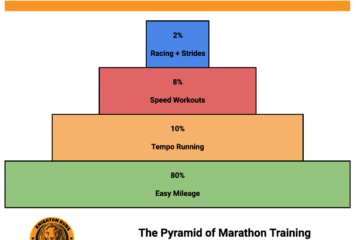The Right Way to Increase Your Running Mileage
Patiently increasing your mileage is the best way to run faster
Author: Coach Chris Knighton

Disclosure: This article may contain affiliate links. When you buy through links on our site, I may earn an affiliate commission. As an Amazon Associate I earn from qualifying purchases.
Introduction
Your running mileage matters.
Increasing your mileage is the best thing you can do to improve your running speed and endurance. But too many runners, coaches, and training plans do not go about it in the right way.
That’s because, if you increase mileage too quickly or do not simultaneously prioritize your recovery between runs, your increase in mileage will likely backfire in the form of injury or stagnation.
What is the optimal amount of mileage for you? Well, if your goal is to be the fastest runner you can be, then the optimal amount of mileage is the highest amount you can handle while still enjoying running and without getting hurt.
The key to increasing your weekly running mileage is to do it gradually and patiently, like I do in The Complete Marathon Training Program.
Listen to This Article as a Podcast
Why running mileage matters
Running more is the best thing you can do to become a better distance runner.
Running itself gives you all the physiological benefits you need to run faster and longer. All cross training and supplemental exercise is purely meant to allow you to run more and run better. These activities do not necessarily make you a better runner by themselves.
By running more mileage, you spend more time on your feet. Your heart spends more time pumping hard, which builds your aerobic engine ever more powerful. You stress and rebuild your skeletal-muscular system which is essential for running stronger and with more frequency.
There is a point for all athletes in which they hit their upper limit for mileage. Every individual can only handle so much, but until you get there, more mileage is the right answer.
Where building mileage goes wrong
One popular way of increasing mileage include the well-known 10% rule, where you only increase mileage by 10% per week. The problem with this is that the math just doesn’t work out in many cases. When following this approach, low mileage runners will hardly see their mileage increase at all, whereas higher mileage runners will increase their mileage too quickly. In addition to the exponential growth of mileage that the 10% rule implies, it also does not schedule in periods of lower mileage that are essential for recovery.
Another popular approach with new marathoners is to just lay out a “long-run schedule”, consisting of 16-milers, 18-milers, and 20-milers, and follow that trajectory regardless of its effect on the total weekly mileage. This approach typically leads new runners to increase their mileage far too quickly while simultaneously overemphasizing the weekly long run. Simply put, this style training plan is a recipe for injury and if you do survive it you will most likely still not feel prepared come marathon race day due to sheer struggle associated with completing the long runs in this manner.
A better way to increase your mileage
A smarter way to increase mileage is by designing “blocks of training” that last four weeks at a time.
The first three weeks have steady mileage. Let’s say for example, 20 miles total in each of the first three weeks.
In the first week, the mileage is new. Your body needs to adapt to it.
In the second week, the mileage stays steady. Your body is becoming more comfortable with it.
In the third week, your mileage again stays constant. By the end of this week, you should be very comfortable with the mileage.
Once you are now comfortable with the mileage, take a “recovery week” in the fourth week.
Reduce your mileage by approximately 25% in the fourth week to allow yourself the opportunity to absorb the training from the weeks beforehand and to hedge against injury. In our example, week four would be 15 miles.
Then move onto the next “block of training”. Increase your mileage in the next block by one mile per run completed each week in the previous block. For example, if you ran five days per week in the previous block, increase your mileage by five miles for the next block. In our example, the increase would be to 25 miles per week.
Example running mileage build…
Week 1: 25
Week 2: 25
Week 3: 25
Week 4: 15
Week 5: 30
Week 6: 30
Week 7: 30
Week 8: 23
Week 9: 35
Week 10: 35
Week 11: 35
Week 12: 27
…and so on.
Want a training plan that builds mileage like this? Check out The Complete Marathon Training Program.
How much mileage is “too much?”
While many passionate amateur athletes are captivated by the 100-mile weeks of professionals, this level of mileage must be given the respect it deserves.
High mileage is only good if you match your amount of mileage with the amount of recovery you give yourself. If these two opposing forces are out of balance, your entire training will come crumbling down.
Professionals can run more because they dedicate the majority of their day to recovery. A pro only runs about two hours a day. The other twenty-two hours a day are spent sleeping, strength training, stretching, rehabbing, rehydrating, and eating healthy food.
The passionate adult runner can likely find up to two hours a day to run, but due to the responsibilities of work and family can not match the amount of intentional recovery that a pro puts in. Therefore an amateur runner should not attempt to run as much as them or compare their training to that of professionals.
Can you spare the time to sleep 8-10 hours a night and do prehab exercises for 40 minutes a day? If so that is more than most people. Do what you can while increasing your mileage until you find your highest sustainable amount.
Occasionally I come across athletes who I feel are running too many miles per week for their current fitness level or goals. This is typically the case of “high-mileage runners” who aren’t posting “fast-times” in races. In some cases, a reduction in total mileage to allow for more time to recover between runs, and more of an emphasis on faster running can be beneficial. Once the runner improves at lower mileage, they can consider adding in more mileage for further improvement.
It’s important to remember the while more mileage is better in an ideal world, running more mileage is a stress. Therefore it is only better if you can recover and improve from it. Simply running more miles is not always the answer.
Increasing your mileage from running season to season
A general rule of thumb is to not increase your peak mileage more than 10 miles per week from training season to season.
If you only manage to run 30 miles per week before your first marathon, in your next season you could train up to 40.
If that goes well, consider going up to 50 in the next season.
Being patient with and intentionally delaying the growth of your mileage over the years will give you a longer and healthier career in distance running.
Summary
For most adult runners, gradually and patiently increasing their mileage from season to season is one of the best way to improve running performances.
Break training into “blocks” of four weeks at a time. In each block, run a steady mileage for three weeks followed by a recovery week. Then increase mileage in the next block.
Don’t compare yourself to other runners or professionals. It’s never a good idea to increase your mileage too quickly or try to cram it in. Avoiding injury is paramount to success.
Every increase in mileage needs to be matched by an increase in recovery to keep improving and not get injured.
Increase mileage by up to 10 miles from season to season. A steady but long-term approach to mileage growth will result in a longer and healthier career in running than quickly increasing your mileage “to your limit” in just one or two years.
Would you like to follow my training program which follows this methodology?
Check out The Complete Marathon Training Program by Knighton Runs Marathon Coaching.




1 Comment
Derek M Cerjanec · September 2, 2021 at 9:24 AM
Another great article! Good information.
Comments are closed.